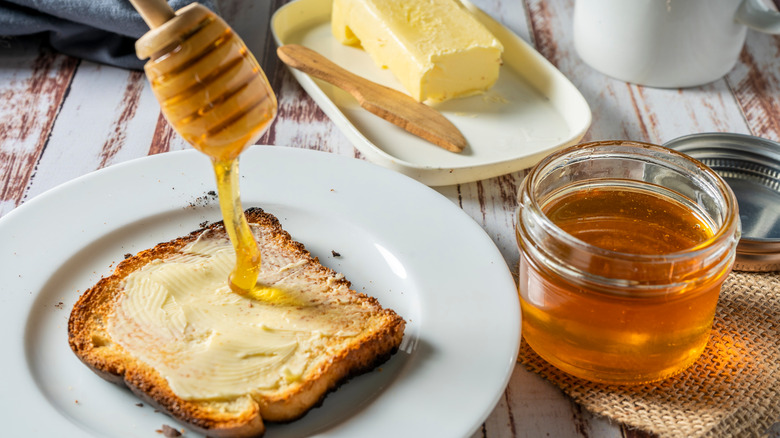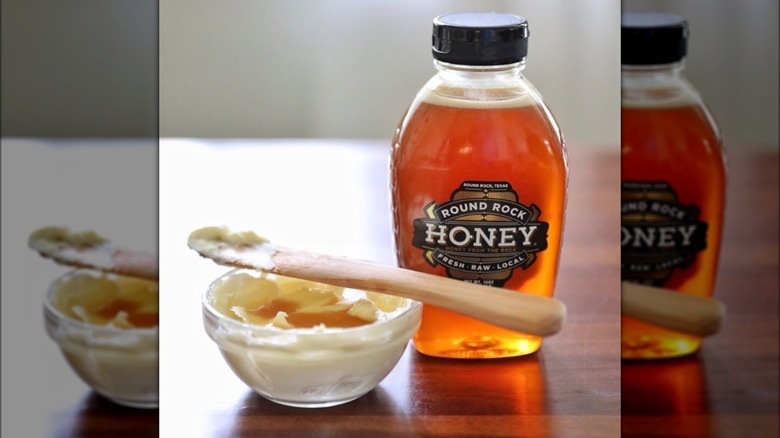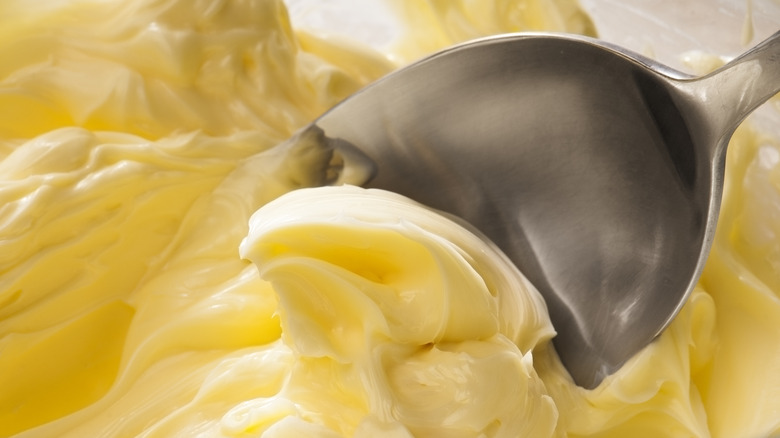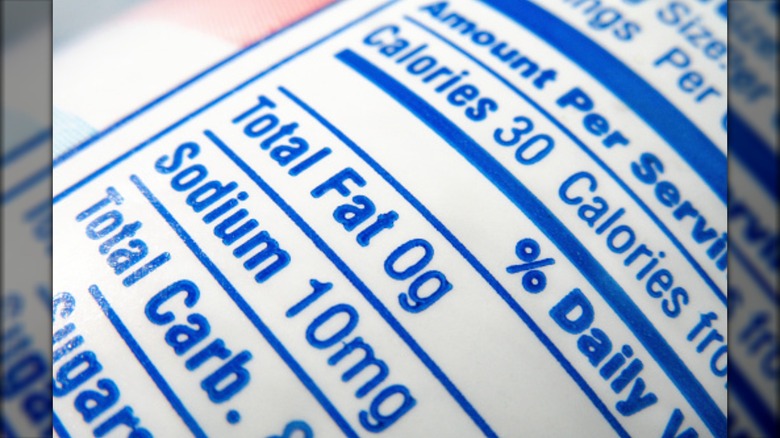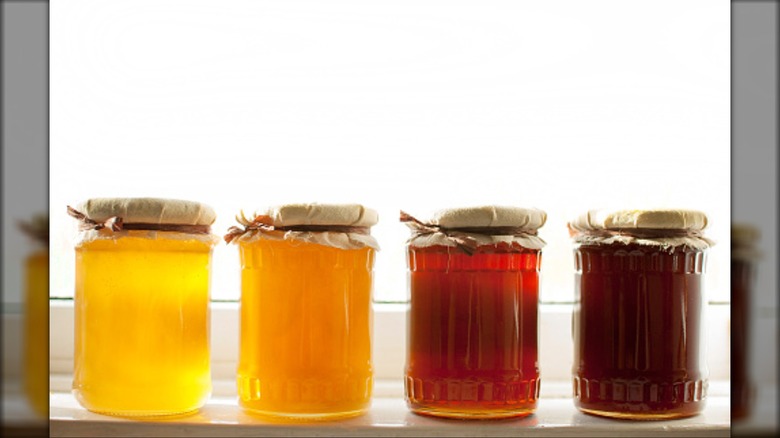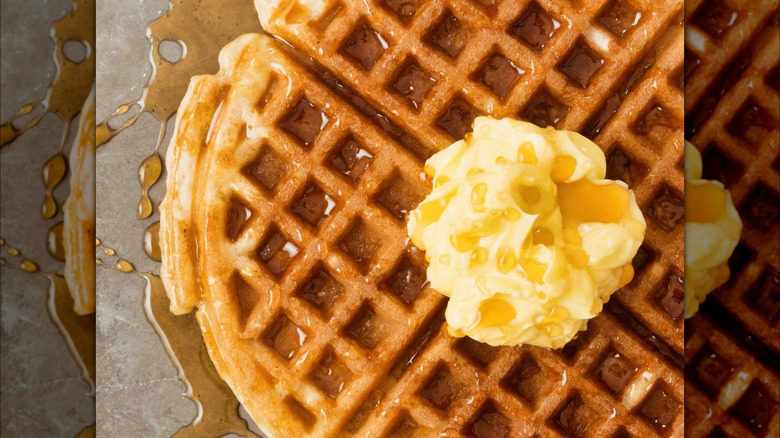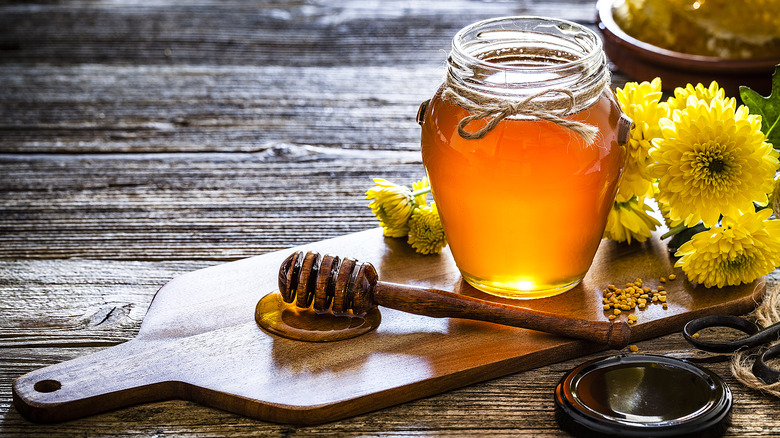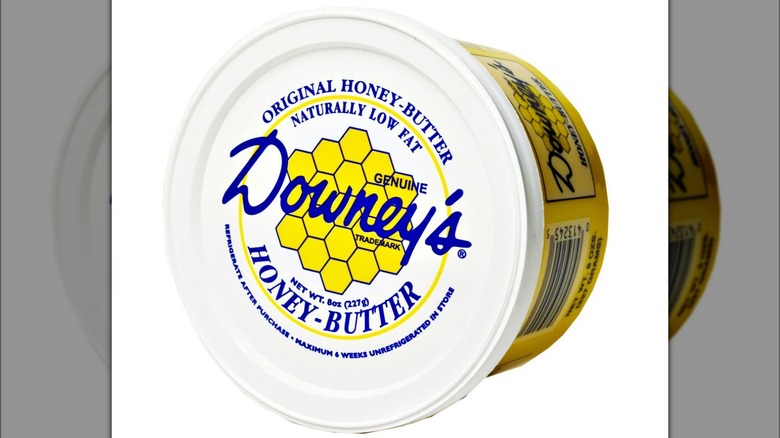What Exactly Is Honey Butter And How Can You Use It?
We may receive a commission on purchases made from links.
Honey butter is one of my secret weapons in the kitchen. Easy to make yet deeply flavorful, I've found that a creamy smear of honey butter can instantly transform the normally mundane into something truly extraordinary. With just a few ingredients and minimal prep, it's well worth it to whip up a quick batch of honey butter to have on hand.
There's an undeniable spark of delicious magic that happens when the savory richness of butter combines with the floral sweetness of honey. And while you might be somewhat familiar with honey butter, you still might have some lingering questions about this tasty spread. What's the right ratio of honey to butter? What are some easy ways to deliciously infuse it with some variety? How should it be stored? We answer all of these questions and more. So if you're looking to expand your skills in the kitchen and deepen your understanding of what honey butter can do, then read on because you're in the right place.
What is honey butter?
Delicious and versatile, honey butter is a spread that's good on everything from pancakes and waffles to fried chicken and dinner rolls. As its name suggests, it's only made with two ingredients: honey and butter. A little pinch of salt is often included too, which amplifies the richness of the butter and the sweetness of the honey.
Some restaurants offer honey butter as a breakfast spread along with jams and jellies or serve it beside fresh bread as an appetizer before lunch or dinner. Honey butter's simple yet enticing flavor profile gives it mass appeal; it can be found everywhere from home kitchens and farmers markets to humble diners and upscale restaurants. Honey butter is often slathered with a knife or scooped with a spoon and then spread onto food. Equally sweet and savory, honey butter is an eclectic and beloved condiment that's used on a wide variety of dishes. It's commonly associated with southern cuisine since it's often paired with biscuits and cornbread.
How is honey butter made?
Honey butter is made by mixing honey and butter with just a little bit of salt. If you'd like to make some at home, the good news is that honey butter is very easy to make. It's better to use unsalted butter so that you can adjust the level of salt in the recipe to your own preference. The most important thing to remember here is the temperature of the butter. When better is refrigerated, it's firm and solid which obviously makes it very difficult to stir. So the best thing to do here is to remove your butter from the refrigerator first with enough time to let it come to room temperature before you make your honey butter. That way, the butter is soft enough to easily blend with the honey. Letting butter come to room temperature usually takes around 30 to 45 minutes. If you want to speed up the process, you can always microwave the butter — but be extra careful with this method, because you don't want to completely melt the butter.
As far as measurements go, aim for equal parts honey and butter. Whisk them together in a bowl until the spread is smooth and homogenous. Add a little pinch of salt, stir, and taste along the way. Honey butter shouldn't be overly sweet or too buttery —- ideally, it should blur the line between them, walking a perfect balance of flavor and texture.
Nutritional information about honey butter
The nutritional information on honey butter depends on the butter and the honey in the recipe. In general, one tablespoon of honey contains about 17 grams of sugar and 64 calories. Honey also contains antioxidants, vitamins, and minerals. Most of the honey that's sold in grocery stores is pasteurized, which means that it's been heated and processed to remove its yeast. When honey is labeled as raw, this typically means that the honey hasn't been pasteurized or filtered. Raw honey tends to have some more nutritional value than processed honey.
A single tablespoon of butter tends to contain about 100 calories and over 11 grams of fat. Because butter is mostly fat, it's considered a high-calorie food. That said, there can be variations in fat content depending on the brand of butter, so it's best to consult the nutritional information that's printed on the labels of the products that you're working with. Of course, the same applies if you're using a premade honey butter that was purchased from the store.
Varieties of honey butter
At first, honey butter seems pretty straightforward. But there can be some surprisingly delicious variations of this spread that only require an extra ingredient or two. Even just the type of honey used can make a big difference. Buckwheat honey, for example, has a distinctive flavor that can add some serious character to honey butter.
Sprinkling some cinnamon into the mix works wonders, too. Cinnamon adds an earthy sparkle of spice that tastes like the perfect pairing for both the honey and the butter. If you want to add some sweet heat, try dicing up some jalapenos and mixing them into your honey butter with a little drizzle of maple syrup. The spicy zing of chili peppers is somewhat subdued by the maple syrup, resulting in a sweet and spicy spread that's deliciously balanced — and also fantastic on cornbread. For a fruitier flavor, try mixing in some peach preserves. The delicate flavor of peaches blends in seamlessly with the honey, adding a floral fruitiness to the honey butter that's truly mouthwatering. Keep your eyes open for different varieties of honey butter at grocery stores like apricot orange, apple spice, and blueberry pecan.
How to use honey butter
The beauty of honey butter is in how many different dishes that it can be used on. For breakfast, try enjoying honey butter on toaster waffles, french toast, muffins, and pancakes. Think of it this way: honey butter's creamy sweetness makes it a great replacement for anything that you'd normally put a little maple syrup on.
Even just a simple piece of toast can be seriously elevated with a dab of honey butter. For lunch, try spreading some honey butter on bread with some cheddar cheese and turkey for a simple but delicious sandwich. Honey butter also has plenty of uses for dinner. To keep it simple, you can always serve it with some freshly-baked dinner rolls along with any kind of entree. It's also delicious brushed onto some good old fashioned barbecue fresh off the grill, like smoked ribs. The touch of honey gives the ribs some sticky sweetness and the butter adds some extra lusciousness. If you want to jazz it up a little, try adding in a little minced garlic, which can also be put to good use on chicken wings, stir-fried shrimp, broccoli, sweet potatoes, or salmon.
How to store honey butter
Honey butter should be stored in an airtight container and refrigerated to maintain its freshness. Because homemade honey butter tends to be made in relatively small batches, a smaller-sized container with a firmly locking lid should do the trick. Butter is best stored towards the back of the refrigerator where it's coldest; try not to store it along a shelf on the fridge's door, since it tends to be a little less cold there (due to items on the door being exposed from opening and closing on a regular basis).
When you're ready for some honey butter, just scoop some out of the refrigerated container and dollop it into a smaller bowl (like a custard cup). Then put your honey butter container back in the fridge, but leave your little portion of honey butter on the counter. After about 30 minutes or so, it should be softened up to about room temperature and ready to spread. In other words, it's best to keep your honey butter stored in the fridge, but then scoop out what you want to use as needed and let it come to room temperature. All you have to do is remember to spoon some out from the fridge with enough time for it to soften a bit and you're golden.
Where to buy honey butter
Honey butter is available in most grocery stores in the refrigerated section. You should be able to find it near other refrigerated butters, dips, and spreads. Depending on your location, it may be somewhat of a gourmet item that's only available at some select specialty grocery stores. Take a peek around your favorite grocery store and see if you can spot some to give it a try.
Local farmers markets can be another great option to track down some high-quality honey butter. Small businesses that specialize in selling products made with local honey and other regional ingredients from nearby farms may carry honey butter and similarly flavored spreads. Beyond knowing that the honey butter is fresh, buying honey butter from local farmers markets is an opportunity to support the small business community in your neighborhood. Buying food at farmers markets can strengthen the local economy in a way that's sustainable and also cuts down on the cost and environmental toll of shipping. If you can't find any pre-made honey butter at the stores or markets around you, you can always buy the ingredients separately and easily make your own batch at home.
